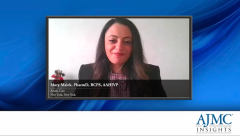
PrEP Adherence During COVID-19
Episodes in this series

A payer discusses preexposure prophylaxis adherence rates during the COVID-19 pandemic and what her team has done to help reengage patients.
Transcript:
Mary Malek, PharmD, BCPS, AAHIVP: We've been monitoring the adherence to HIV medications and to PrEP [preexposure prophylaxis] during the pandemic. We have seen changes. We've seen new patterns that we weren't used to before.
When it comes to HIV … when March came around, we saw a surge … in prescriptions. A lot of patients panicked, a lot of providers’ offices as well, and people wanted to have enough supply on hand. ... We saw a surge in prescription fills in March.... Things went down a little bit in April and May, when it came to prescription fills, and it could be for a couple of reasons. Patients might have had already enough from this huge supply they had in March, or patients were hospitalized, especially in New York. A lot of patients, unfortunately, did acquire COVID-19 [coronavirus disease 2019] and were hospitalized, and we did hear that from a lot of providers, too, when we asked why is there a gap in April and May….
But, when June came back, from June to August, we saw the numbers go back to normal, to where they were before the pandemic. A lot of things calmed down. Many providers’ offices were open again. The overall vibe was better, patients were easily accessing medications, easily getting back to normal life. We did see things normalize between June and August, and we are continuing to see that.
When it came to PrEP, though, it was a different story. Again, it started the same way. In March, we saw a surge. Everybody was getting prescriptions. ... But, starting April to August, we saw a downward of fills. ... Of course, this was concerning for us, and we did speak with multiple patients to see why this is happening….
When I spoke to patients, they told us that during the pandemic, everybody was locked at home.Patients weren't seeing each other. There were less relationships. People didn't need to be on PrEP. They didn't feel like they were at risk at that time. ... Of course, that wasn't the case for everyone. We only saw about a 2[%] to 3% decrease in the population that had access to PrEP, but it's still a decrease. We think that is the main reason why there were less fills for PrEP….
But, when we spoke to these patients, we wanted to make sure that we counselled them on an especially important point, which is how long it takes for PrEP to start working again. Maybe you stopped it now, and that's fine. But I always made sure to tell our patients that PrEP takes 7 to 21 days to start working again, depending if it's anal or vaginal tissues—7 to 21 days that you have to take your medication before you get back to relationships and to normal. And that's a really important point, and it's definitely scary, because a lot of people might have missed that…. We tried our best to remind our patients.... We heard from some providers that, again, patients were not accessing PrEP. They looked atPrEP as just prevention, and it really wasn't on the top of the list of important actions during COVID-19.
You remember during COVID-19 a lot of preventive services were stopped; a lot of elective surgeries were stopped. It wasn't really assigned as a critical or essential task to be continued, which is absolutely unfortunate, because having HIV prevention should always be on top of our list. But providers saw that less patients were accessing PrEP, and what's more unfortunate is some people did seroconvert during the time of COVID-19, because they're not taking PrEP. They don't feel at risk, or they just don't feel ready to get back to normal and take medications like they were before.
Some people did seroconvert that our providers saw, and HIV seroconversion or HIV infection in the beginning just looks like flulike symptoms. A lot of people were confusing HIV seroconversion with having COVID-19. A lot of people came into the offices and said, “I have signs and symptoms of COVID-19,” while they actually had HIV conversion. That was very unfortunate, but a lot of these providers knew their patients, so they did test them for HIV, and that's how they found out that they did seroconvert. We … need to get our patients started again on PrEP. And if they have stopped PrEPand they do feel these flulike symptoms, we need to be testing them for HIV and to make sure that they have not seroconverted at that time. … And we've been trying our best to reach all our patients that have stopped and just try to have people come back on track and just get back to normal again, to where they were pre-COVID-19, but, again, it always takes time.
Newsletter
Stay ahead of policy, cost, and value—subscribe to AJMC for expert insights at the intersection of clinical care and health economics.


























































